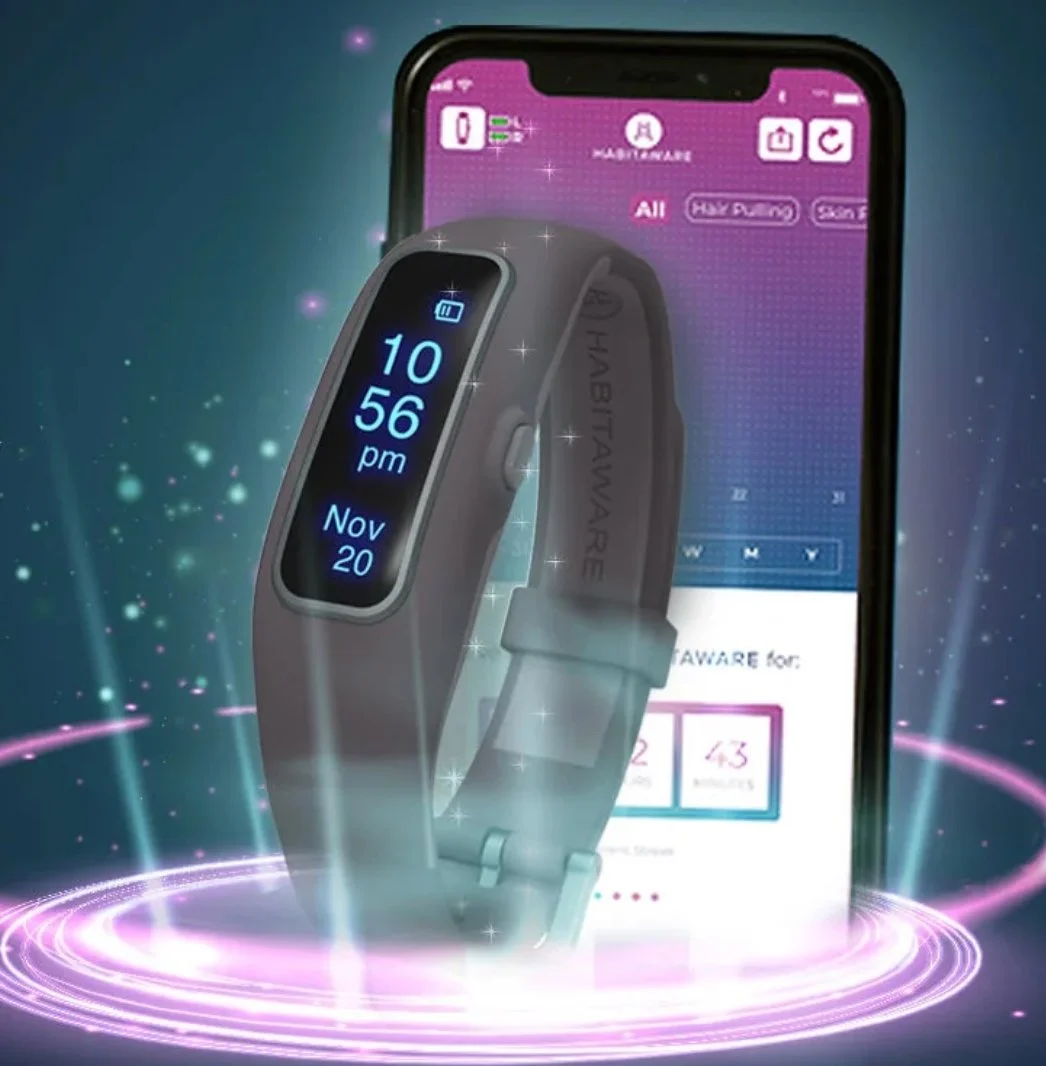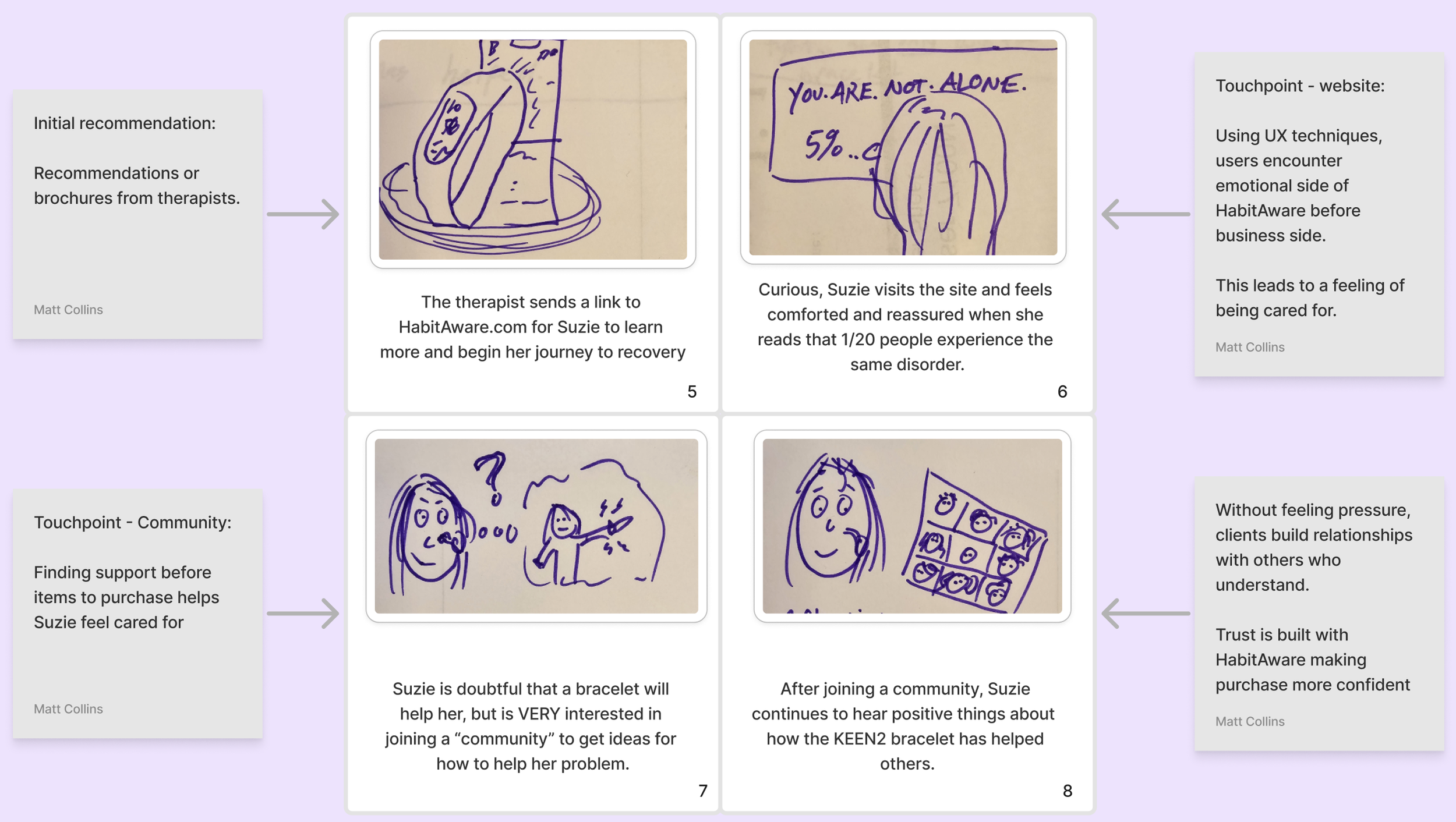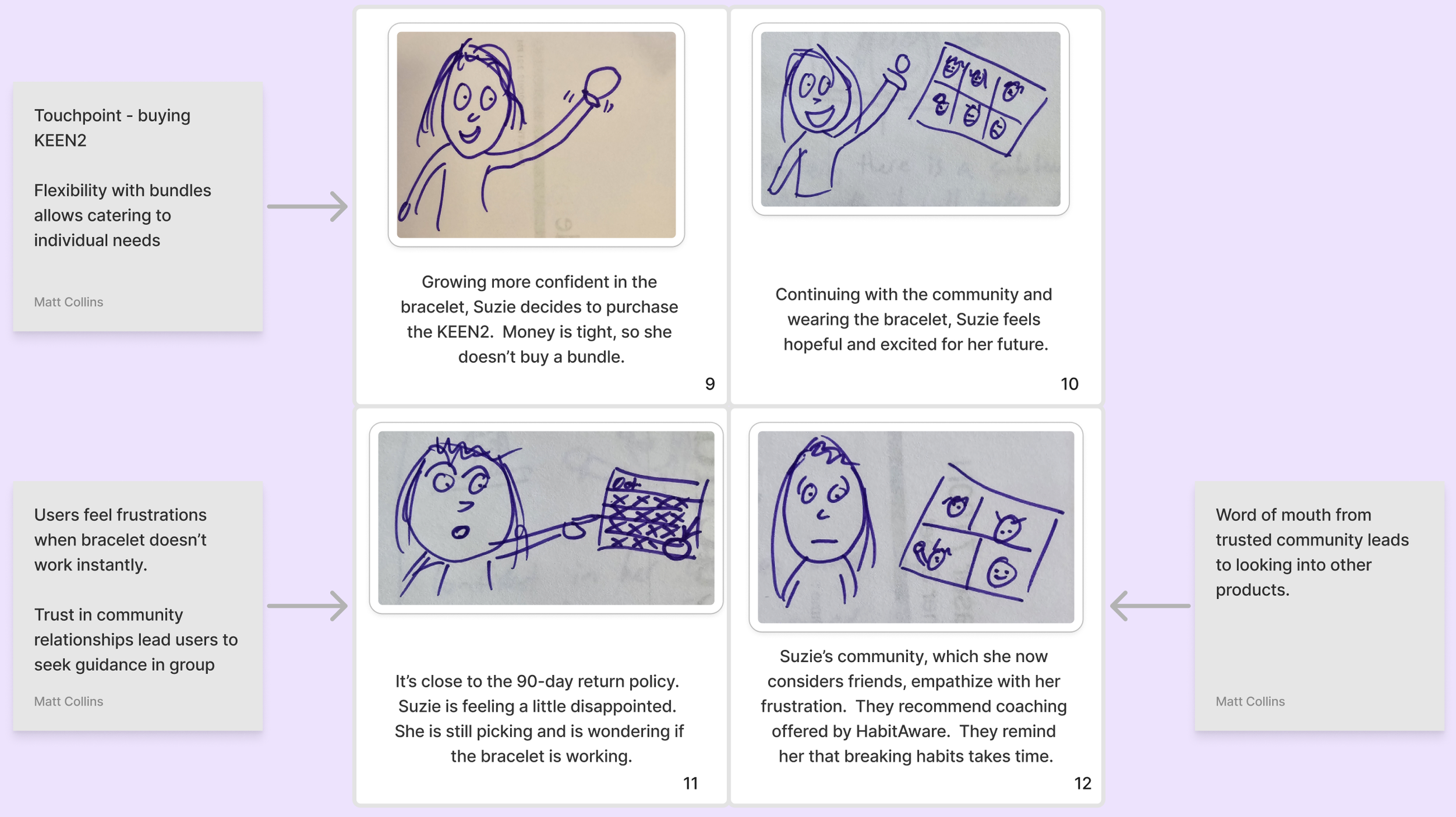HabitAware
Supporting individuals struggling with body-focused repetitive behaviors (BFRBs), the innovative smart bracelet Keen2 helps users develop awareness of habitual actions such as hair pulling, nail biting, face picking, and thumb-sucking. By fostering this awareness, the device empowers users to take control and implement positive changes to reduce or eliminate these unwanted behaviors.
You are not alone.
Background
ThThe project focuses on enhancing the user interface and accompanying materials to emphasize the holistic nature of the HabitAware program, showcasing it as more than just a bracelet. The goal is to make it easier for users to understand how KEEN2 integrates with other resources, such as coaching and community support, for a more comprehensive approach. The primary audience includes individuals with BFRBs and their parents or guardians, while the secondary audience consists of healthcare providers.
To humanize the experience and highlight the program’s additional services, the team developed storyboards depicting user journeys, illustrating how various users might discover and engage with the product. Guided by strategic statements, principles, and an experience map, the team’s recommendations include revamping the homepage, improving the GLAAM! Masterclass page, and deploying digital advertisements in relevant spaces to increase visibility and impact.
Team - Damian Wojtowicz, Trevor Charon, Liz Chiles, Ayantu Gamtessa
Role - Researcher, user storyboard designer
Date - October, 2024
Methods - Content inventory and audit, secondary deep-dive research, graphic organizers, user journey mapping, experience mapping, design critique, think-aloud protocol, storyboarding
Tools - Google Slides, Google Docs, Figjam, sketching
Body-focused repetitive behaviors (BFRBs) impact countless individuals worldwide. Many who struggle with these behaviors feel isolated, believing they are alone in their experience, which often fosters a deep sense of shame. Those who seek help may face misdiagnosis, frequently being labeled with obsessive-compulsive disorder (OCD), despite the fact that BFRBs are more rooted in habitual and subconscious actions than the compulsive tendencies of OCD. Breaking these behaviors often requires consistent awareness—providing individuals with reminders of their actions so they can consciously redirect themselves and form healthier habits.
Defining the Problem
Onychophagia:
It is estimated that around 30% of the population bites their nails.
Dermatillomania:
The TLC Foundation for Body Repetitive Behaviors (BFRBs) estimates 5% pick at scabs and blemishes subconsciously.
Trichotillomania:
5% of Americans pull out their hair as a disorder.
Purpose
The goal of this project was to propose a design strategy centered on the experiences of individuals with BFRBs (and their parents, if they are minors), guiding them through a clear, supportive path that illustrates how HabitAware can assist in their journey. This strategy aimed to effectively communicate HabitAware’s offerings to potential users, emphasizing why each component is an essential step toward BFRB recovery.
My contribution to the project was the development of a storyboard, which depicted a potential user and her journey across various HabitAware touchpoints. This visual narrative was designed to highlight the user’s experience, showcasing how HabitAware’s tools and resources could seamlessly support her at every stage of her recovery process.
Iteration and Evaluation
After being introduced to HabitAware’s challenges and concerns, I conducted secondary research to explore the types of counseling therapies commonly offered for BFRBs. Through this research, I identified seven key therapeutic techniques currently in practice:
• Cognitive Behavioral Therapy (CBT)
• Decoupling
• Acceptance and Commitment Therapy (ACT)
• Comprehensive Behavioral Treatment (ComB)
• Dialectical Behavior Therapy (DBT)
• Emotional Regulation Module
• Habit Reversal Training (HRT)
While the underlying causes of BFRBs remain largely unknown, these methods provide structured approaches to help individuals manage and reduce these behaviors. BFRBs are often linked to mental health conditions such as anxiety and stress, making it essential to address these underlying factors as part of the treatment process. For instance, managing anxiety can significantly decrease urges like lip-biting or hair-pulling. A dual approach, treating both BFRBs and related mental health issues simultaneously, is considered more effective, as it provides a comprehensive treatment. While therapies do not guarantee complete recovery, they offer individuals the best chance at achieving progress and managing their condition effectively.
Additionally, I conducted an experience map to identify touchpoints, pain points, and emotions experienced throughout the various stages of engaging with HabitAware’s tools and resources. This mapping process offered valuable insights into the user journey, highlighting opportunities to enhance support and foster a more empowering experience for individuals dealing with BFRBs.
Finally, an annotated storyboard was developed to present HabitAware with an alternative approach to how users could purchase the product and associated packages. This visual representation highlighted a streamlined and user-friendly process, emphasizing clarity and convenience to enhance the overall customer experience. By mapping out each step in the purchasing journey, the storyboard provided actionable insights and recommendations for improving accessibility and engagement in the product selection process.
Next Steps
If given more time to work on HabitAware, I would focus on developing a comprehensive approach to presenting all that the organization has to offer. This would ensure that users receive a clear and cohesive message that they are genuinely supported and cared for throughout their journey. I would emphasize positioning the bracelet as an integral part of a broader, holistic path to managing BFRBs, highlighting how it connects with additional resources such as coaching, community support, and therapeutic tools. This would help users understand that HabitAware is not just a product but a partner in their journey toward recovery and well-being.









